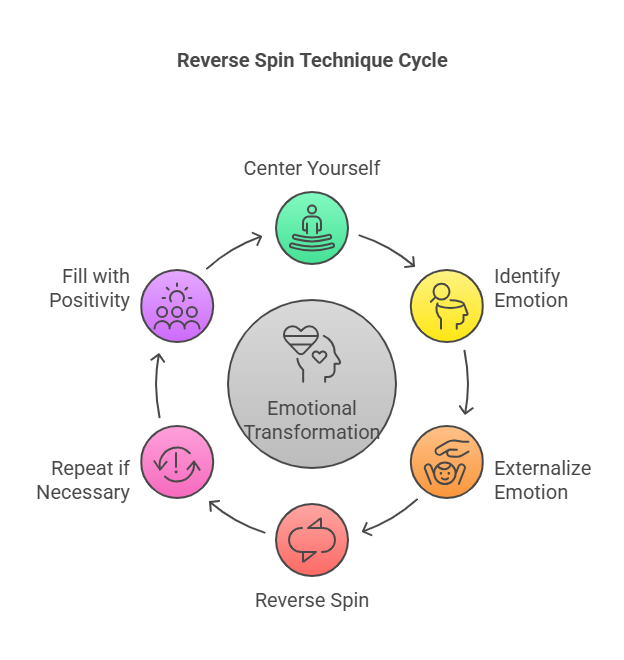Productivity is more than just checking items off a to-do list; it’s the key to reaching our personal and professional goals, staying motivated, and feeling accomplished. However, procrastination often stands in the way, creating stress and leaving us feeling stuck.
Whether it’s the fear of failure, perfectionism, or simply being overwhelmed by the size of a task, these mental barriers can keep us from making meaningful progress
The good news? You can break free from procrastination quickly by addressing its root cause your emotional state.
This article introduces the Reverse Spin Technique, a powerful visualization method rooted in psychology and neuroscience that can help shift negative emotions and eliminate procrastination in minutes.
The Psychology of Procrastination

We’ve all been there staring at a to-do list while mindlessly scrolling or organizing our desk for the fifth time. But procrastination isn’t laziness it’s often a deeper, emotional reaction hiding beneath the surface.
Emotional Triggers
Procrastination isn’t just about avoiding work it’s about avoiding the negative emotions tied to a task. You may put off a project because you’re afraid of failing, unsure where to start, or worried that it won’t be perfect. Instead of facing discomfort, your brain opts for short-term relief through distractions like social media, TV, or busy work.
The Procrastination-Emotion Connection
When you see procrastination as an emotional response rather than a productivity flaw, you can address its root cause the emotions holding you back. Instead of battling willpower, the key is to change how you feel about the task, making it easier to take action. This is where the Reverse Spin Technique comes in.
Introduction to the Reverse Spin Technique
The Reverse Spin Technique is a simple yet effective visualization method that helps you neutralize negative emotions linked to procrastination. By changing how emotions feel in your body, you can disrupt negative thought patterns and replace them with a more positive, action-driven mindset.
How It Works on a Psychological Level
The technique is based on somatic psychology, which explores how emotions manifest in physical sensations. When we experience stress or anxiety, our body holds onto these feelings as tightness, heaviness, or discomfort in different areas. By externalizing, visualizing, and reversing the emotion’s “movement”, we can create distance from negative feelings and regain control over our actions.
Step-by-Step Guide to the Reverse Spin Technique
Center Yourself with Deep Breathing
Before shifting emotions, you need to calm your nervous system.
- Try the 4-7-8 breathing technique:
- Inhale deeply through your nose for 4 seconds.
- Hold your breath for 7 seconds.
- Exhale slowly through your mouth for 8 seconds.
- This method reduces stress, clears the mind, and signals your brain to shift into a focused, relaxed state.

Identify and Externalize the Emotion
- Ask yourself: Where do I feel this resistance or stress in my body?
- Common areas include the chest, stomach, or head.
- Visualize pulling the feeling out of your body and placing it in front of you as an object, color, or shape. This externalization creates psychological distance, making it easier to work with.
Use the Reverse Spin Technique
- Notice how the emotion “spins” does it feel like it’s moving forward, backward, clockwise, or counterclockwise?
- Slow the spin, then gradually reverse its direction.
- As you do this, imagine the emotion losing its intensity turning lighter, smaller, or even dissolving.
Repeat if Necessary
- If the emotion persists, repeat the process.
- You can visualize throwing the emotion away or replacing it with a calming color or sensation.
Fill the Void with Positivity
- Once the negative emotion is gone, replace it with confidence, focus, or excitement.
- Picture a bright, energizing color filling the space where the old emotion was.
- This step ensures the negative feeling doesn’t return, reinforcing a new, action-oriented mindset.
Why the Reverse Spin Technique Works
The Reverse Spin Technique isn’t just a clever mental trick it’s rooted in real psychology and neuroscience. By shifting how your body and brain respond to discomfort, it helps you break free from procrastination at its emotional core.
Scientific Backing on Visualization Techniques
- Visualization is widely used in Cognitive Behavioral Therapy (CBT) to help rewire negative thought patterns.
- Studies show that mental imagery can influence neural pathways, effectively altering emotional responses.
Neuroscience of Emotional Regulation
- When you consciously modify how an emotion feels in your body, you override automatic stress responses.
- This technique helps rewire the brain’s reaction to tasks that previously triggered procrastination.
Breaking the Cycle of Procrastination
- Unlike temporary motivation hacks, this method directly addresses the emotional resistance behind procrastination.
- Over time, practicing this technique builds emotional resilience, making you less prone to future procrastination.
Practical Tips to Reinforce the New Mindset
The Reverse Spin Technique helps neutralize negative emotions that trigger procrastination, but to make lasting changes, you need to reinforce the new, action-oriented mindset. The following strategies will help solidify your progress, making it easier to stay productive and prevent future procrastination.
Take Action Immediately
The best way to lock in the positive emotional shift is to take immediate action after using the Reverse Spin Technique.
- Start with a small, manageable task related to what you were avoiding. It could be something as simple as opening the document, writing the first sentence, or setting up your workspace.
- Taking even a tiny step signals to your brain that you’re moving forward, making it easier to continue.
- Why it works: The brain thrives on momentum. Once you take the first step, your brain is more likely to stay engaged and complete the task.
Example: If you were procrastinating on writing a report, immediately open your laptop and type the title after using the Reverse Spin Technique. Even this small step reduces resistance and increases the likelihood of completing the report.
Use Affirmations and Positive Reinforcement
Your thoughts shape your actions, so reinforcing the new mindset with positive affirmations helps you stay motivated and avoid slipping back into procrastination habits.
- Repeat a simple affirmation that aligns with your new mindset. Some powerful examples include:
- “I take action with ease and confidence.”
- “I am in control of my time and energy.”
- “I complete tasks effortlessly and stay focused.”
- Say these affirmations out loud or write them down before starting your task.
- Why it works: Affirmations help reprogram negative self-talk, replacing self-doubt and fear with confidence and motivation.
Example: If you often procrastinate because you feel overwhelmed, saying “I break big tasks into small steps and tackle them one by one” can shift your perspective and make tasks feel more manageable.
Celebrate Small Wins
Acknowledging progress is a key part of rewiring your brain for sustained productivity. Even small accomplishments deserve recognition.
- Track your progress by making a checklist and crossing off tasks as you complete them.
- Reward yourself after completing a task this could be as simple as taking a short break, enjoying a cup of coffee, or listening to a favorite song.
- Remind yourself that every step forward counts, no matter how small.
Why it works:
- Celebrating achievements triggers dopamine release, reinforcing positive behavior.
- It helps create a sense of accomplishment, which builds motivation to continue.
- Over time, your brain associates productivity with positive emotions, making it easier to stay on track.
Example: If you finish the first draft of an email you were procrastinating on, take a moment to acknowledge your progress and say, “Great job! That wasn’t as hard as I thought.”
Conclusion
Procrastination isn’t just about putting things off it’s your brain’s way of dodging fear, doubt, or overwhelm. The Reverse Spin Technique is a quick, powerful tool to shift those emotions and get back in control.
But real change sticks when you reinforce it. So take action now: use a positive affirmation, celebrate a small win, and most importantly start. The more you practice, the less power procrastination holds over you.
Try it today: Pick one task you’ve been avoiding, apply the Reverse Spin Technique, and take that first small step.
Remember, productivity isn’t about being perfect it’s about building momentum.
Start now. Your future self will thank you.





